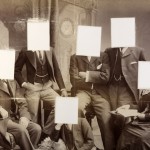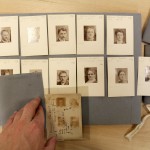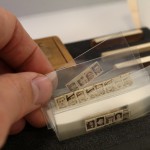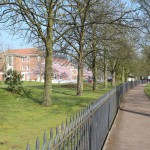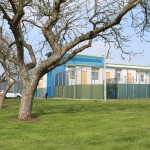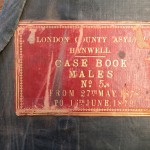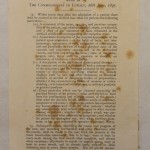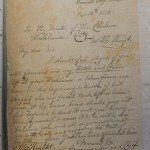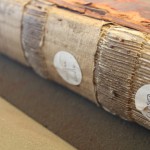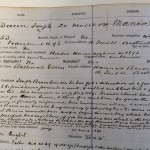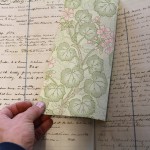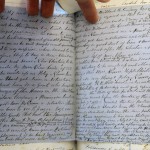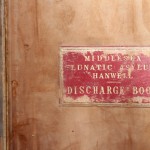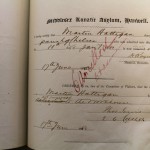panopticon remixed. A collage of architectural layouts that informed the prison revolution in nineteenth-century: Bentham’s panopticon, Millbank Prison, Pentonville Reformatory. These layouts of disciplinary institutions formed a central reference for Michel Foucault’s panopticism that is now seen as an important characteristic of contemporary surveillance society. Editing: Raul Gschrey: gschrey.org
Schlagwort-Archive: london
Galton Papers: A Researcher’s Nightmare
Research visit to the „Galton Papers“, University College London, Special Collections, April, 2015.
The „Special Collections“ of University College London are housed in the central library of the University. Only library card holders can enter, so a member of staff picks me up at the high-security entrance gate. After a hike through corridors, I am let to a room where on a library cart a huge pile of boxes and folders waits for me. This is quite a lot of stuff, and I have only ordered the material that seemed to be essential. Galton was an avid collector and everything seemed to be of interest: from letters to photographs, notebooks and articles, envelopes and scraps of paper. This is as much a heaven as a nightmare for a researcher like me. Here I will spend the next days, sifting through the material. The collection is well arranged and a considerable part of the material on and by Francis Galton was digitised recently. But especially with photographs and notes, it is important to consult the originals. To order and categorise the photographs, for instance, Galton used a form of binding. These small booklets that resemble flip books and that could be described as preliminary stages in the production of composite portraits. Often there are notes on the back of the prints, for instance, the remark: “This man’s nose spoils the composite.” Also the notebooks and letter books can be accessed as originals.
The material kept in the collection leads to further London museums and archives where information on Galton’s photographic practice is kept, such as the Metropolitan Archive, the Bethlem Museum and Archive, the Huxley Collection at Imperial College and the National Archives.
Museum of the Mind
Research visit to the “Bethlem Museum of the Mind” & Bethlem Hospital Archive London, April, 2015.
A suburban train takes me to “Eden Park”, not only by name an idyllic village in the south-eastern periphery of London. In the back streets the cherry trees are in full bloom. I cross a creek and walk along the fence of an open space that resembles a huge park until I reach the entrance of Bethlem Royal Hospital. The “Bethlem Museum of the Mind” and its archive are located on the grounds of the psychiatric hospital that is still in operation, after a long history that dates back into the twelfth century. The representative central building of this complex that was inaugurated in 1930 has just recently been opened as the new museum. Here archivist and curator Colin Gale awaits me behind the reception desk. We have a chat about the institution and the museum, especially in late nineteenth century when Francis Galton visited the clinic and commissioned portraits of patients for his photographic experiments with the composite technique.
The portraits of 76 male and 65 female patients are preserved among the “Galton Papers” at the Special Collections of University College London. The frontal, half-length portraits carry a number as well as family names. The archive at Bethlem holds the admission and discharge books as well as the medical files. By comparing the periods of treatment of different patients, who were often also photographed as part of the asylum’s procedure, the photos in the “Galton Papers” can be dated to 1880-1882. Also, not only names, but information on age, profession, family history, as well as the diagnosis notes on the treatment of the mental illness can be drawn from the material. The entries tell veritable stories of the life and fate of the individuals that were used as source material for Galton’s experiments with the composite technique. And while composite portraiture was aimed at de-individualising and typifying, these documents give back an identity and personality to the objects of study. Furthermore the photographs and the material kept at Bethlem Hospital, provide insight into the disciplinary institutions and their policies, modes of categorisation and typification of their clients, often by visual means. Museum of the Mind weiterlesen
Recording Race: Huxley
Recording Race: T. H. Huxley’s Photographic Survey of the Races of the British Empire. Research visit to the „Thomas Henry Huxley Papers“, Imperial College London, April 2015.
It is certainly not easy to get an appointment at the archives of Imperial College London, where the “Thomas Henry Huxley Papers” are kept. This is the only archive I have encountered so far that would make a letter of intent, a project description, as well as a letter from my supervisor and university a prerequisite for consulting the materials. However, after settling all those issues, I am received cordially and a seat and research aids have been prepared for me.
Thomas Henry Huxley was a traveler, biologist and educational reformer, he is however best known as an important advocate of Darwin’s theory of evolution. He shared a circle of friends with Charles Darwin, Herbert Spencer and Francis Galton, with whom he exchanged letters that are kept in the archive. For instance in a letter dated October 16th, 1886, Francis Galton asks Huxley’s opinion on the biographies of Erasmus Darwin and Charles Darwin in relation to a proposal for a monument.
Races of the Empire
I am, however, particularly interested in his project of a visual survey of the ‘races’ of the British Empire, that was launched in 1869, and for which Huxley developed a anthropometrical photographic standard for the depiction the human body. The plan originated in the Ethnological Society of which Huxley was president, and which sought to improve the quality of data in the field and establish a scientific classification of the ‘races’ of the British Empire. The project however was administered by the Colonial Office in London that sent out an official request to the colonial administrations and forwarded the material, photographs and letters, to Huxley. Even though the material that he received was never used in his publications or in the work of the Ethnological Society, the portraits represent an important, if problematic, insight into the practices of scientific photographic depiction of the human body and in particular of colonial subjects. Recording Race: Huxley weiterlesen
Hanwell Asylum Records
Research Trip: Hanwell Asylum Records, Metropolitan Archives London, April 2015
It is more of a coincidence when I end up at the gates of the Metropolitan Archives for the first time. I have been visiting the Imperial War Museum, or rather the building that now houses this institution. This was the former site of Bethlem Asylum, when the clinic was still located in central London in nineteenth century. Only the monumental entrance and central wing are still existent. When I walk back to a friend’s place, a new bright green suit in my shopping bag, I suddenly realize a small sign indicating the entrance of the Metropolitan Archives. A member of staff tells me that they will not be open for much longer today, but that there will be an exceptional opening on the coming Saturday. That’s when I return to study the material on Hanwell Asylum, the other psychiatric hospital where Francis Galton had photographs taken for his experiments on composite portraiture. Also material on Guy’s Hospital is available here. In this institution, with the aid of the physicist F. A. Mahomet, photographs were taken of tuberculosis patients to compose facial superimpositions.
In the UCL “Galton Papers” I have compiled a list of names of Hanwell Asylum inmates whose portraits were taken on Galton’s request. In the entry and discharge books as well as in the patient records that are kept here, I am able to trace a number of the persons. Dating the photographs is however not as easy as in the case of Bethlem. As a county asylum Hanwell was dealing with a larger number of long-term patients. And, unlike at Bethlem, patients were not photographed as part of the asylum’s internal procedure, or at least no portraits and no nineteenth century photographs of the institution have survived as part of the case books in the Metropolitan Archives. This makes identification and dating of the photographs that became part of Galton’s collection of portraits of psychiatric patients from Hanwell difficult. However, in a number of cases, I was able to establish identities of individuals and could date the production of the photographs to 1880-81.
Hanwell, or as it was officially called “Middlesex County Asylum” was the first pauper asylum in Middlesex, it was opened in 1831 and successively enlarged in 1837, 1857 and 1879. In 1888 it had 1891 patients. It was one of the first institutions in Britain that followed a non-restraint system, but in a contemporary report it was criticized for its low number of attendants and medical staff and the intransparent medical and administrative decisions.[1] As a state-financed institution, the number of patients was higher and the average time they spent at the Asylum was longer, compared to the privately-run Bethlem that catered for the middle classes. The patients were mainly workers from the lower classes; among the patients that I could trace in Galton’s portrait series the case files identify as: laborers, weavers, carpenters, bricklayers, butchers, shop assistants, clerks. Just like in the Bethlem files, the medical case books contain personal information, such as occupation and marriage status, individual and family medical history, diagnoses and notes on the development of the disease, as well as prescriptions. Also in these files the hereditary focus is strong and they often contain a mental family history.
[1] See: Winslow, Forbes: „On the Management of Hanwell Lunatic Asylum“. In: The Journal of Psychological Medicine and Pathology 2, 1849, 418.
Phantomgesichter
Erhältlich bei Wilhelm Fink Verlag
Endlich ist das von Uli Richtmeyer herausgegebene Buch zur Konferenz und Ausstellung „Phantomgesichter“ in Potsdam erschienen.
Biometrische Verfahrensweisen stehen im Zentrum gegenwärtiger Sicherheits- und Überwachungsprogramme. Auch in diversen fotografischen Apparaten, die das Material für digitale Bilddatenbanken liefern, haben sie sich fest etabliert. Obwohl sie auf komplexen Berechnungen basieren, sind biometrische Verfahren wesentlich als Bildbearbeitungstechnologien zu verstehen – so die Grundannahme des Bandes. Erst aus dieser Perspektive gelangen die spezifischen Sicherheiten und Unsicherheiten biometrischer Bilder in den Blick. Sie fallen besonders dort auf, wo sich Biometrie auf ein klassisches Objekt der Erkennungsdienste, das menschliche Gesicht, bezieht. Welche Konsequenzen sich aus der Vorgeschichte und Gegenwart der verwendeten Bildtechnologien sowie ihren trivialen und professionellen Gebrauchsweisen für den Status des artifiziellen Gesichtsbildes ergeben, gilt es nun zu hinterfragen.
U.a. gibt es darin einen Artikel zu meinem Promotionsprojekt. Raul Gschrey: „»A surprising air of reality« – Kompositfotografie zwischenwissenscha licher Evidenzbehauptung und künstlerischer Subversion.“

De-Composing Composites
Research visit to the Galton Collection London July 2014
This time easily find my way to Wolfson House in a side street of London’s Euston Station. At the door I am greeted by the porter who was also present last year. I am early, so I go up and sit down in the staff kitchen in the fifth floor where I meet Subhadra Das some minutes later. We chat for some time and it feels like coming home. The archive has returned to its old location after the refurbishment, this allows me to view the collection of artefacts and instruments that was packed away last time. I am here to explore the sources of the composite portraits and to trace connections to other archives and institutions.
Addressing Artefacts
Later in the morning a group of visitors from an American University arrives and Subhadra gives a tour through the collection. She skillfully uses individual artifacts and objects to guide through Galton’s career and his major achievements. A serviette ring with pyramids hints at the young explorer’s travels to Cairo and up the Nile, the source of the Nile being a recurrent subject in Galton’s later work in the National Geographic Society. A quite similar shaped, but entirely different object, a South-West-African wristband shows his travels as the first European into the interior of what is today known as Namibia. Prove of his gift as a developer are specifically designed apparatuses for morse communication by use of a mirror, a portable finger printing machine, as well as calipers and measuring devices for anthropometrical purposes. It is hard not to collapse in the hot and tiny rooms, but this approach to Galton’s through the objects in the collection really makes sense and could be a great contribution to the publication on composite photography I am planning as part of my project. Subhadra closes her tour with an observation of analogies in the character structure between Galton an the notoriously self-centered nerd character Sheldon in the US TV series “The Big Band Theory” and involves the psychology students in a discussion about the characters oscillating between genius and madness.
Instruments & Measurements
The most interesting part of the collection of objects are the various measuring instruments. Unlike many of his contemporaries Galton developed and designed many of the instruments himself. De-Composing Composites weiterlesen


